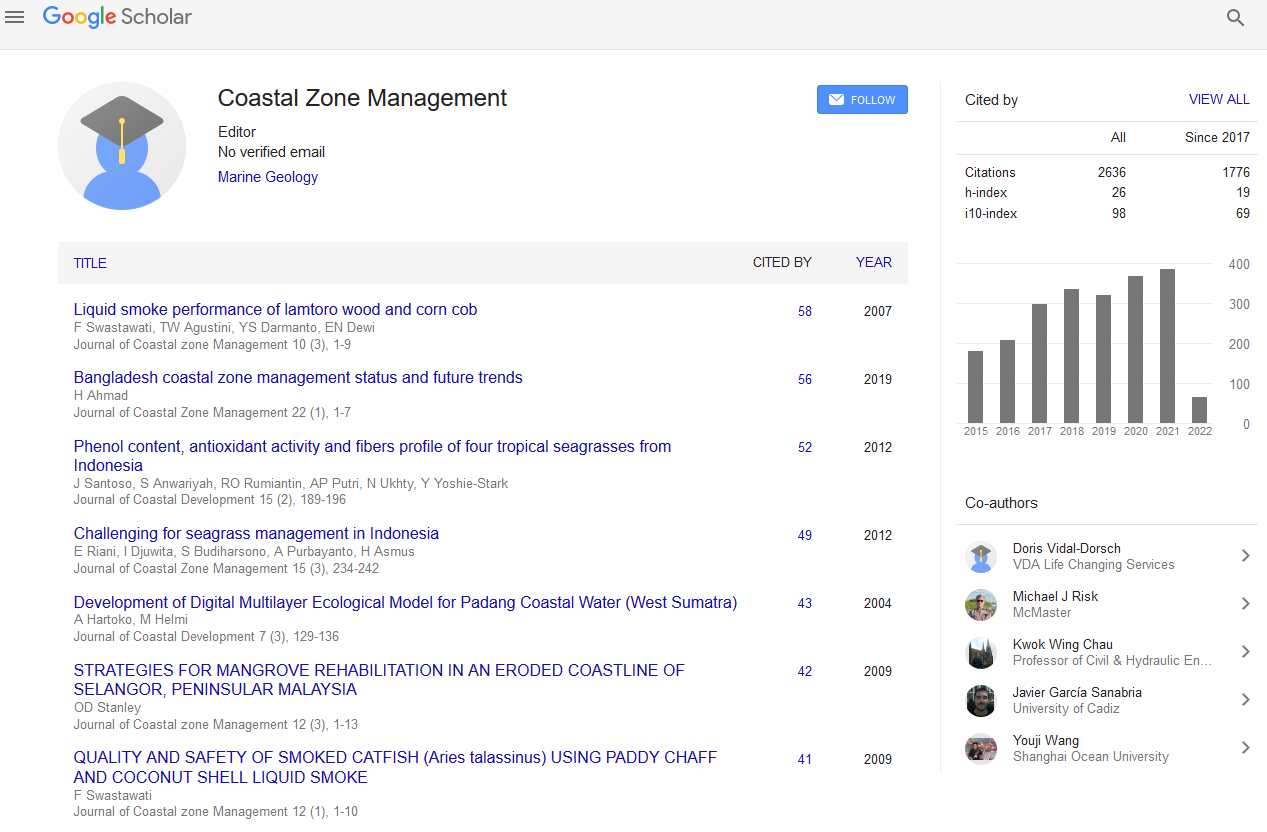Indexed In
- SafetyLit
- RefSeek
- Hamdard University
- EBSCO A-Z
- OCLC- WorldCat
- Publons
Useful Links
Share This Page
Journal Flyer

Open Access Journals
- Agri and Aquaculture
- Biochemistry
- Bioinformatics & Systems Biology
- Business & Management
- Chemistry
- Clinical Sciences
- Engineering
- Food & Nutrition
- General Science
- Genetics & Molecular Biology
- Immunology & Microbiology
- Medical Sciences
- Neuroscience & Psychology
- Nursing & Health Care
- Pharmaceutical Sciences
Research Article - (2019) Volume 22, Issue 1
Heavy Metal Pollution Assessment in Sediment of Mussel Habitats UsingGeochemical Indices
Hossein Saberi Kouchesfehani1* and Seyed Naser Azizi22Department of Chemistry, University of Mazandaran, Babolsar, Iran
Received: 17-Feb-2019 Published: 08-Mar-2019
Abstract
The heavy metals Pb, Cd, Cu, Zn, and Ni were analyzed in the soft tissue of mussels (Anodonta cygnea) as well as in sediments at five regions of Anzali Wetland, on the southern bank of the Caspian Sea during October and November 2016. The data were applied for assessing the pollution levels in emphasizing the mussel habitats by geochemical indices and furthermore answering the inquiry whether these indices can predict the contaminant level in the swan mussel soft tissue.
The highest geochemical indices in the sediment: EF, Igeo, CF, and PLI revealed moderately to seriously contamination level of Cd and Pb in sampling sites. The sheijan and Bahambar also showed a higher contamination level of metals than in other regions. According to the ecological risk index (RI) Mahrouzeh, Hendekhaleh, Abkenar, and Bahambar areas were presented within the range of moderate risk level. Additionally, multivariate statistics showed that Ni is controlled by parent rocks and at the same time Pb, Cd, Cu, and Zn originated from anthropogenic sources.
The highest geochemical data for Pb, Cd, Cu, Zn, and Ni recorded in Bahambar, Abkenar, Mahrouzeh, Sheijan, and Mahrouzeh respectively. But the highest accumulation of Pb, Cd, and Cu in mussel measured in Bahambar, Abkenar, and Mahrouzeh respectively, and also Zn and Ni in Hendekhaleh. Therefore, the geochemical index data does not always predict heavy metal contaminants into the soft tissue of mussels in sampling sites.
Keywords
Geochemical indices; Mussel; Heavy metal; Pollution; Coastal
Introduction
Heavy metals are dramatically important for their bioaccumulation potential into the flora and fauna organisms in a wetland ecosystem where may act as a sink for metal pollution [1-3].
Geochemical indices and bioaccumulation data have been found necessary for risk assessment of contaminants, including trace metals in the aquatic ecosystem [4].
The Anzali wetland, because of its role in the preservation of unique species, such as swam mussel was enrolled in the Ramsar convention as an international wetland [5]. This wetland was influenced by a large amount of urban, industrial, wastewater, and aquaculture waste, which may lead to an expansion in the level of metals.
Various geochemical indices have been developed to assess heavy metal contamination in sediment [6], which sediment quality guidelines (SQGs) [7], enrichment factor (EF) [8], contamination factor (CF) [9], pollution load index (PLI) [10], geoaccumulation index (Igeo) [11] and potential ecological risk Index (RI) [12] have pulled in more consideration lately. The objective of the present work was to ponder the distribution and contamination level and potential risks of heavy metals in vital natural locales utilizing the Igeo, EF, CF, PLI, RI, SQGs indices. The statistical analysis as a capable tool also applied to acquire the pollution conditions in this coastal wetland [13] and to answer the inquiry whether these indices can predict the contaminant level in soft tissue of mussel in five particular imperative environmental areas.
Materials and Methods
Study regions
The open surface area of Anzali wetland is estimated at 58 km2 with latitude and longitude coordinates of 37˚28 ́N and 49˚25 ́W respectively. This wetland with the maximum depth of 2 meters and an average depth of lower than 1 meter gets its water mostly by direct and surface spillover from encompassing area uses. This intricate biological community incorporates an extensive variety of inland, beachfront and marine living space. For this study, twenty-five sampling stations from this area were selected at five Study regions (Figure 1).
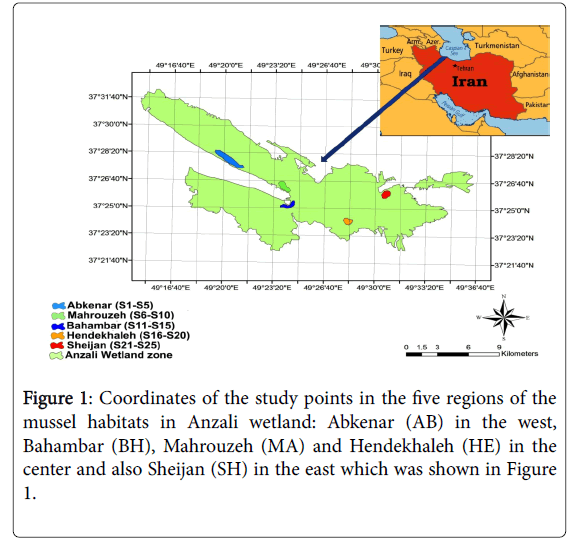
Figure 1. Coordinates of the study points in the five regions of the mussel habitats in Anzali wetland: Abkenar (AB) in the west, Bahambar (BH), Mahrouzeh (MA) and Hendekhaleh (HE) in the center and also Sheijan (SH) in the east which was shown in Figure 1.
Sample collecting and analysis
In the wake of acquiring authorization from the Environmental Protection Agency of Bandar Anzali, Mussels (10 from each region) were collected from 5 regions and also, the sediments in the depth of almost 10-20 cm from where the mussels were taken in a once-off testing trip in October and November 2016. The sediment samples were dried totally to a consistent weight in an oven at 45°C for 48 hrs. The dried sediments were then ground and passed through a <63 μ nylon sieve.0.5 g of prepared sample was digested with 8ml of concentrated HCl,HNO3 in proportion to 1HCl/3HNO3 and 3 ml of concentrated HClO4 for 6 hrs at 90°C. The processed samples were then diluted to 25 ml with deionized water [14].
The soft tissue of Mussels were dissected and put away at −80°C until the examination. Digestion of soft tissues was done by nitric acid using the methodology depicted for analysis [15]. In this Analysis technique, one gram of the sample and 10 ml of concentrated nitric acid was placed in a 250 ml digestion container. The mixture became slowly boiled for 30-45 minutes to oxidize the effortlessly oxidized mixes and cooling this mixture, 5ml of 70% HClO3 was added and become slowly boiled till a thick white smoke appeared. It changed into then cooled again, 20 ml of distilled water was delivered, and the mixture changed into boiled so that no additional smoke wound up noticeable.
The solution transformed into then cooled and filtered in Whitman paper. Water added into conveying to the degree to achieve the check in a 25 ml Erlenmeyer. A blank digest was additionally arranged using the same procedure. The concentrations of Pb, Cd, Cu, Zn, and Ni inside the digestion solution and the blank were obtained with a flame atomic absorption spectrometer (Analytic Jena version NOVA 400P) using standard reference materials (AccuStandard, Inc., USA). The metal concentration in the sediment and mussel is expressed as mg kg−1 dry weight. All statistical calculations were performed by Excel 2010 (p<0.05) and XL stat software (version: 2016.02.28451). The correlations among the concentrations of heavy metal between the random variable were also explored using Pearson correlation test (p<0.05)
Results and Discussion
In sediment
Results of statistic tests, including maximum, minimum, and standard deviation of surface sediments and mussels are displayed in Table 1.Comparing the greatest mean concentrations of heavy metals in sediments, Zn (117.90 mgkg-1) in Sheijan, was significantly different from those in Abkenar, Hendekhaleh, and Mahrouzeh areas. The highest mean concentrations of Ni (25.28 mg kg-1) and Cd (1.58 mg kg-1) also recorded in Mahrouzeh and appeared significantly different comparing with all other regions. The highest mean value of Pb (31.20 mg kg-1) watched in Sheijan, which significantly different with the other regions. The highest mean value of Cu (42.12 mg kg-1) was also estimated in Bahambar and revealed no significant differences with all other regions. The data also showed that the values of Zn, Cu, Pb, and Cd were more than the background values (Table 1) [9]. Which may be associated with anthropogenic activities, such as industrial and municipal wastewater and ship transportation [16].
| Sampling regions | Element | Zn | Cu | Ni | Cd | Pb |
|---|---|---|---|---|---|---|
| Mahrouzeh | Concentration± SD | 60.63 ± 24.14 | 34.34 ± 4.51 | 25.28 ± 1.17 | 1.58 ± 0.16 | 25.53 ± 1.48 |
| Range | 38.04 - 96.05 | 28.12 - 40.10 | 23.47 - 26.30 | 1.36-1.80 | 21.03 - 27.26 | |
| Hendekhaleh | Concentration ± SD | 55.82 ± 24.42 | 28.93 ± 8.54 | 21.93 ± 2.23 | 1.18 ± 0.26 | 23.16 ± 2.40 |
| Range | 30.77- 89.04 | 17.45 - 35.30 | 18.60 - 24.50 | 0.89 - 1.48 | 19.18 - 25.30 | |
| Bahambar | Concentration ± SD | 87.80 ± 44.04 | 41.45±6.09 | 17.83 ± 1.10 | 0.90 ± 0.36 | 24.64 ± 3.95 |
| Range | 31.17 - 30.69 | 30.69 - 45.00 | 15.45 - 20.38 | 0.38 - 1.22 | 18.44- 27.75 | |
| Sheijan | Concentration ± SD | 117.9 ± 15.39 | 32.20 ± 8.06 | 15.46 ± 0.82 | 0.56 ± 0.13 | 31.26 ±2.54 |
| Range | 97.19 - 37.38 | 18.32 - 38.76 | 14.20 - 16.21 | 0.36 - 0.72 | 26.96 -36.67 | |
| Abkenar | Concentration± SD | 49.00 ± 14.3 | 30.81 ± 12.24 | 10.70 ± 1.73 | 0.98 ± 0.34 | 18.99 ± 2.54 |
| Range | 31.20 - 63.90 | 17.61 - 48.44 | 8.69 - 12.59 | 0.64 -1.38 | 16.06 - 21.58 | |
| mussel | Concentration± SD | 37.05±12.60 | 3.43±0.175 | 0.62±0.28 | 0.083±0.01 | 0.423±0.150 |
| Range | 22.82- 49.16 | 3.24-3.69 | 0.30-1.09 | 0.07-0.09 | 0.16-0.52 |
Table 1: Element concentration of surface sediments and soft tissue of mussels from sampling regions (mg kg-1).
The metal concentrations in sediment were near the range of those found previously by Jamshidi [17]. Who measured Zn in the range of 90.77-203.61 mg kg-1, Cu in the range of 31.60-111.45 mg kg-1, Ni in the range of 60.34-105.15 mg kg-1, Pb in the range of 13.01-93.00 mg kg -1, and Cd in the range of 0.05-1.4 mg kg-1. In this study, the extent of heavy metal pollution in Sheijan and Hendekhaleh and also the distribution of metal patterns (Zn>Cu>Pb>Ni>Cd) were similar to those recorded in previous research, except for Ni which was higher than Pb in previous assessment
The enrichment factor
The enrichment factor (EF) can be utilized to determine the contamination and risk stage for surveying the level of contamination in the sediments [18] which calculated using the subsequent equation [19].
EF=(CMe/CFe)sample/(CMe/CFe)
Background Where (CMe/CFe) in the sample is the ratio of heavy metal concentration (CMe) to the concentration of Fe (CFe) in the sediment sample and (CMe/CFe)in the background is the same reference ratio in the background sample. The estimations of around 1 recommend that metals originated from natural sources [20]and also EF>1.5, 1.5–3, 3–5, 5–10, and>10 were showed the beginning of human impact, minor, moderate, intense, and really excessive level of enrichment factor respectively [21]. The EF of sampling sites is shown in Figure 2.
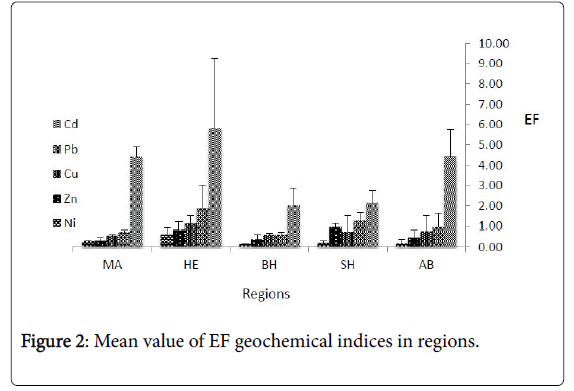
Figure 2. Mean value of EF geochemical indices in regions.
The mean EF values for all the metals aside from Zn and Ni were discovered more than 1, showing enrichment of metals. Furthermore, the highest of EF for Pb and Cd appeared in the range of moderate and severe enrichment level which may derive from anthropogenic impacts (Figure 3). The Low EF values of Ni affirmed that it originated from the natural processes. Comparatively, among Abkenar, Hendekhaleh, Bahambar, Mahrouzeh, and Sheijan significant differences of EF were also observed for all metals with the exception of Cu. Geoaccumulation index (Igeo) has been broadly utilized for the assessment of soil and sediment To depict the level of metals contaminations[22]. Which calculated using the equation.
Igeo=log 2/Cn1.5Bn
Where Cn is the concentration of metal n in the sediment and Bn is the geochemical background value of element n in the background sample [23-25]. The values of 1.5 might be demonstrated the most reduced human effect level and can be characterized in seven levels: practically uncontaminated, Igeo ≤0—uncontaminated to moderately contaminated, 0 ≤ Igeo ≤ 1—moderately contaminated, 1 ≤ Igeo ≤ 2— moderately to heavily contaminated, Igeo ≤ 3 heavily contaminated, 3≤Igeo ≤4—heavily to extremely contaminated, 4 ≤ Igeo ≤ 5, and extremely contaminated, 5< Igeo.
The Igeo data in this study have increased the order of Cd (+0.72) in Mahrouzeh< Pb (+0.12) in Sheijan < Cu (−0.27) in Bahambar < Zn (−0.28) in Sheijan < Ni (−1.83) in Mahrouzeh (Figure 3).
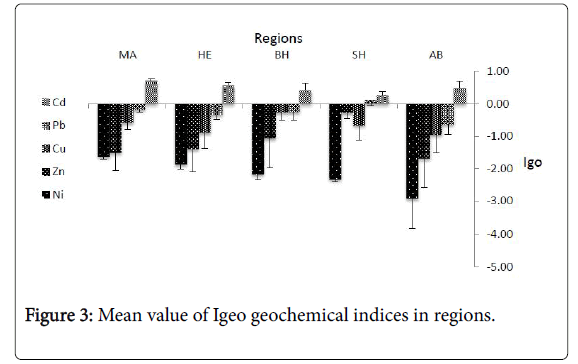
Figure 3. Mean value of Igeo geochemical indices in regions.
The Igeo values of Cd and Pb also indicated un-contamination to moderately level contamination in sediments. Additionally, Igeo mean qualities for Ni, Zn, and Cu showed unpolluted status.
Contamination factor
The CF was obtained by dividing the concentration of each metal by the foundation estimations(reference value) of metal which CF<1, 1 ≤ CF<3, 3 ≤ CF<6, and CF ≥ 6 represent low degree, moderate degree, considerable degree, and a very high degree of contamination respectively [26,27]. According to the data, the highest mean estimations of CF in the study regions for Cd (5.8) in Mahrouzeh demonstrated a considerable degree of contamination and also, Pb (1.86) in Sheijan, Cu (1.14) in Hendekhaleh, and Zn (1.24) in Sheijan, showed a moderate degree of contamination, while Ni (0.49) in Mahrouzeh revealed the low degree of contamination (Figure 4).
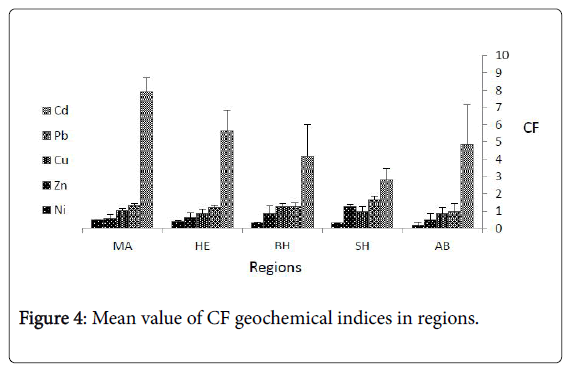
Figure 4. Mean value of CF geochemical indices in regions.
Pollution load index
To identify the metal contamination as a total scale in sediment, Tomlinson recommended an equation for calculating the pollution load index (PLI).
PLI=(CF1 × CF2 × CF3 ×…× CFn) 1/n
Where n is the number of metals. PLI>1 indicates pollution and demonstrates dynamic deterioration of the quality, whereas PLI<1 shows no pollution condition. PLI value of zero indicates the starting point of becoming infected [28]. PLI also can provide some understanding about the quality of wildlife inhabit and information to the decision-makers on the pollution of the regions [29]. The calculated PLI values of metals in sediment are shown in Table 4 which ranged from 1.04 to 0.86, 1.02 to 0.70, 0.99 to 0.73, 0.88 to 0.72, and 0.78 to 0.53 for Sheijan, Bahambar, Hendekhaleh, Mahrouzeh, and Abkenar, respectively. The data confirmed that the sediment in Sheijan and Bahambar were more contaminated than other areas (PLI >1) (Table2).
| zone | Abkenar | Sheijan | Bahambar | Hendekhaleh | Mahrouzeh | |
|---|---|---|---|---|---|---|
| PLI | Mean, SD | 0.65 ± 0.09 | 0.94 ± 0.07 | 0.88 ± 0.07 | 0.86 ± 0.12 | 0.76 ± 0.04 |
| Range | 0.78-0.53 | 1.04-0.86 | 1.02-0.70 | 0.99-0.73 | 0.83-0.72 | |
| RI | Mean,SD | 167.34 ± 52.76 | 110.37 ± 19.95 | 151 ± 71.37 | 192 ± 35.75 | 258.01 ± 25.04 |
| Range | 218.11-106.38 | 130.71-75.03 | 202.35-69.58 | 234.35-50.36 | 287.74 ± 218.79 | |
Table 2: Pollution load index and risk index value of heavy metals in sediment regions (mean ± SD).
The risk index
RI is used for better understanding the integration of metals pollution and ecological risk potential which can be calculated by the following equation. The Tri were valued: Zn= 1, Ni=5, Cu=5, Pb=5, and Cd=30.
Eri=Tri X Cfi =Tri X (Ci /Cn)
RI=Σ Ni
RI is characterized into four gatherings: RI<150, 150 ≤ RI<300, 300 ≤ RI<600, and RI ≥ 600 which indicated low, moderate, high, and very high ecological risk level [12]. Due to the high concentrations of cd in Mahrouzeh, Hendekhaleh, Abkenar, and Bahambar and also Tri value of Cd, RI index was higher in these areas comparing to Sheijan and placed in the range of moderate ecological risk level (Table 2).
Sediment quality guidelines
SQGs are used to comprehend the distinction in contamination in marine biological communities [30] applying the many potential contaminants (e.g. polynuclear aromatic hydrocarbons, chlorinated organic, and metals) which are defined on tree levels, Effect range low (ERL), effect range median (ERM) and high impact level (PEL). The low ERL level shows the low effects of metal contaminants, while ERMs and PELs represent probably unpleasant effects of heavy metal pollution (Table 3) [31].
| Heavy metals SOGs | Zn | Cu | NI | Cd | Pb |
|---|---|---|---|---|---|
| Non-polluted | <90 | <25 | <20 | - | <6 |
| Moderate- polluted | 90-200 | 25-50 | 20-50 | - | 40-60 |
| Heavily-polluted | >200 | >50 | >50 | >6 | >60 |
| ISOGsa | 124 | 18.7 | 15.91 | 0.68 | 30.2 |
| ERLb | 150 | 34 | 20.9 | 1.2 | 46.7 |
| ERMc | 410 | 270 | 51.6 | 9.6 | 218 |
| PELd | 271 | 108 | 42.8 | 4.21 | 112 |
| This study | 18.5 | 41.64 | 25.28 | 1.58 | 31.2 |
Table 3: Sediment quality guidelines from NOAA (Long et al., 1995) and environment of Canada cISQG=Environment of Canada and, a ERL=Effect range low (NOAA),b ERM=Effect range medium (NOAA), DPEL=Probable effects level (Environment of Canada).
Comparing the values of heavy metals data in present assessment with the ISOGs table values, Zn (12%), Cu (80%), Ni (52%), Cd (72%), and Pb (12%) were above the levels of the ISOGs which Cd and Cu showing adverse effects on the sedimentary habitat. Concentrations of all metals in sampling sites were also lower than the corresponding values of ERM and PEL suggesting no adverse effects. In addition, Cu (48%), Ni (32%), and Cd (36%) were higher than the ERL amounts, showing portable effect level (Table 3).
Correlation analysis
Pearson correlation analysis (CA) was connected to consider the quality of the connection between random variable [32]. In this research, the significant correlation between the variable in sediment revealed a negative relationship between Pb and pH (-0.502), negative relationship between Pb and TOM (-0.677) positive correlation between Cd and EC (0.600) and negative relationship between Ni and pH (-0.785). The results of -0.503 and -0.599 were also shown a inversely relationship between Zn with EC, and also between Zn with TOM respectively. The significantly positive correlation between the variables indicates that metals have a higher content in higher values of EC, TOM, and EC. On the other hand the correlation between Pb and Ni was 0.572 which may be indicated their common origin in the sediment.
Principal component analysis
Principal component analysis (PCA) is connected to distinguish fewer uncorrelated factors from an expansive arrangement of information by focusing on axes with maximum variance. The PCA data also gives as briefly as possible conceivable valuable data [33] with the most significant variable alongside the base loss of unique information [34].
In this examination, we standardize the information independently by the PCA method for the five distinctive testing areas, comparing the compositional patterns among the sediment samples and distinguishing the factors that correlate with one another.
The first component (F1) recoded 38.55% total variance and positively correlation with Ni, showing different sources of Ni in field study.
Component F2 showed 26.74% total variance and positively correlated with Pb, Cd, and Zn displaying the similar pollution sources such as road transportation, farming and urban wastewater [17,35,]. The fourth component (F4) also, displayed just 8.05 % total variance with positive correlation with Cu, showing the different source of copper in this investigation (Table 4).
| metal | F1 | F2 | F3 | F4 | F5 |
|---|---|---|---|---|---|
| Pb | 0.241 | 0.459 | 0.067 | 0.071 | 0.073 |
| Cd | 0.282 | 0.375 | 0.111 | 0.058 | 0.106 |
| NI | 0.92 | 0.045 | 0.003 | 0.001 | 0 |
| Cu | 0.089 | 0.184 | 0.015 | 0.303 | 0.002 |
| Zn | 0.016 | 0.651 | 0.012 | 0.059 | 0.261 |
| Eigen value | 2.698 | 1.872 | 1.197 | 0.564 | 0.344 |
| Variability % | 38.549 | 26.741 | 17.105 | 8.055 | 4.91 |
| Cumulative % | 38.549 | 65.29 | 82.395 | 90.45 | 95.36 |
Table 4: Eigen values on the correlation matrices of heavy metals and square of factor loadings.
Hierarchical cluster analysis
Hierarchical cluster analysis (HCA) was applied to place sediment data in a group with similar characteristics. The resulting dendogram (Figure 5) grouped all the 25 testing stations into 5 significant clusters. There were 2 sites in the cluster I, 2 sites in cluster II, 5 sites in cluster III, 4 sites in cluster IV, and 11 sites in cluster V.
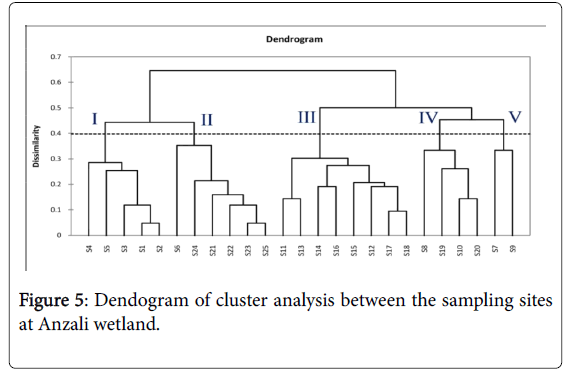
Figure 5. Dendogram of cluster analysis between the sampling sites at Anzali wetland.
The mean concentrations of heavy metals were low in cluster I (S7, S9 in Bahambar). Cluster II consists of S10, S6 in Bahambar that was characterized by the high metal contamination of Pb and Cd. Cluster III that incorporated S21–S25 in Sheijan, showing the higher heavy metal concentrations. Cluster IV consists of S1, S2, S3, and S4 in Abkenar, with a PLI of 0.53, recorded lower contamination than in other clusters. Cluster V including S11–S20 and S8 in Mahrouzeh and Hendekhaleh were characterized by the highest mean concentrations of Pb and Cd which relates to the anthropogenic activities.
For the heavy metals in the tissue of A. cygnea, the highest concentration of Cd(0.093 mg kg−1) and Zn (49.16 mg kg−1) were recorded in Abkenar and Sheijan respectively, and the largest of Pb(0.52 mg kg−1), Ni(1.09 mg kg−1), and Cu(3.69 mg kg−1) were estimated in Mahrouzeh.
To respond to the inquiry whether these indices can predict the contaminant level in the group of swan mussel, the data revealed that Pb concentration in tissues of A. cygnea showed the maximum in Bahambar, but at the same time, the geochemical data displayed Sheijan as the most polluted region. Cd concentration in tissue also was the highest in Abkenar, but the geochemical data showed Hendekhaleh and Mahrouzeh that were more infected. The highest Cu concentration in the soft tissue of mussel measured in Mahrouzeh and unexpectedly, geochemical indices showed the highest Cu concentration in Bahambar. Furthermore a maximum concentration of Zn and Ni in mussel recorded in Hendekhaleh and according to geochemical indices, the most exceedingly bad conditions were watched for these metals in Sheijan and Mahrouzeh respectively. Such inconsistencies are also observed on the values of PLI and RI indices for estimating of heavy metals into the mussels (Table 2). Finally, the results indicated that the geochemical indices can't always predict heavy metal contaminants in mussels which may be because of complicated relationships among vital tissue and its environment. Therefore, simultaneous use of surroundings information, such as geochemical and bioaccumulation data of their vital tissues shows a more comprehensive illustration of the pollutant situation and prevents from going astray in environmental assessment.
Conclusion
In the present investigation, concentrations of Zn, Cu, Pb, and Cd were higher than mean crust values, which suggested that several sampling stations are polluted with these metals and may be a threat to the sedimentary habitat of swan mussel. The EF, Igeo and CF also revealed that sediments in this study were impressively polluted with Cd and Pb.Moreover , Mahrouzeh, Hendekhaleh, Abkenar, and Bahambar also have a moderate ecological risk level according to RI index.
The PLI values of metals in the sediments confirmed that the sediment of Sheijan and Bahambar were more contaminated than other areas (PLI>1).
The multivariate analysis represents that Ni comes from parent rocks, whereas Cd and Pb (most likely) and Cu and Zn (less likely) originate from anthropogenic sources. Comparing geochemical data with metal concentrations in the soft issue of the mussels revealed that the geochemical indices can't always predict heavy metal contaminants in mussels. Therefore, simultaneous use of surrounding information and the bioaccumulation data on organisms present a comprehensive illustration of the pollution condition and prevents from going astray in environmental assessment.
Acknowledgment
Authors are thankful to the analytical Division, Faculty of Chemistry, and university of Mazandaran for providing financial support (No. 20591) and Inland Waters Aquaculture Research Centre, Iranian Fisheries Sciences Research Institute for providing laboratory facilities to complete this study.
REFERENCES
- Burton GA. ES&T Series: Assessing Contaminated Aquatic Sediments. Environ Sci Techno.1992;26:1862-63.
- Ergin M, Saydam C, Baştürk O, Erdem E, Yoruk R. Heavy metal concentrations in surface sediments from the two coastal inlets (Golden Horn Estuary and Izmit Bay) of the northeastern Sea of Marmara. Chem Geol. 1991;91(3):269-85.
- Vaezi A, Karbassi A, Valavi S, Ganjali M. Ecological risk assessment of metals contamination in the sediment of the Bamdezh wetland, Iran. Int J Environ Sci Techno. 2015;12(3):951-958.
- Viarengo A, Lowe D, Bolognesi C, Fabbri E, Koehler A. The use of biomarkers in biomonitoring: a 2-tier approach assessing the level of pollutant-induced stress syndrome in sentinel organisms. Comp Biochem Physiol Part C: Toxicology & Pharmacology. 2007;146(3):281-300.
- Pourang N (1995) Heavy metal bioaccumulation in different tissues of two fish species with regards to their feeding habits and trophic levels. Environ Monit Assess. 1995;35(3):207-219.
- Yang Y, Chen F, Zhang L, Liu J, Wu S, Kang M. Comprehensive assessment of heavy metal contamination in sediment of the Pearl River Estuary and adjacent shelf. Mar Pollut Bull. 2012;64(9):1947-55.
- Pekey H, Karakas D, Ayberk, S, Tolun L, Bakoglu M. Ecological risk assessment using trace elements from surface sediments of Izmit Bay (Northeastern Marmara Sea) Turkey. Mar Pollut Bull. 2004;48(9):946-953.
- Tang W, Shan B, Zhang H, Mao Z. Heavy metal sources and associated risk in response to agricultural intensification in the estuarine sediments of Chaohu Lake Valley, East China. J Hazard Mater. 2010;176(1-3): 945-51.
- Bowen HJM (1979) Environmental chemistry of the elements: Academic Press, London.
- Karbassi A, Monavari S, Bidhendi GRN, Nouri J, Nematpour K. Metal pollution assessment of sediment and water in the Shur River. Environ Monit Assess. 2008;147(1-3):107-116.
- Muller G. Schwermetalle in den sedimenten des Rheins-Veranderungen seit 1971. Umschau. 1997;79: 778-783.
- Hakanson L. An ecological risk index for aquatic pollution control. A sedimentological approach. Water Res. 1980;14(8):975-1001.
- Rossi L, Chevre N, Fankhauser R, Margot J, Curdy R, Babut M, et al. (2013) Sediment contamination assessment in urban areas based on total suspended solids. Water Res. 47:339-350.
- Tuzen M. Determination of heavy metals in soil, mushroom and plant samples by atomic absorption spectrometry. Microchem J. 2003;74(3):289-97.
- Chemists & Chemists. Official methods of analysis of the Association of Official Analytical Chemists. Association of Official Analytical Chemists 2.1920.
- Ayati B. Investigation of sanitary and industrial wastewaters effects on Anzali Reserved Wetland. MAB-UNESCO.2003.
- Jamshidi-Zanjani A, Saeedi M. Metal pollution assessment and multivariate analysis in sediment of Anzali international wetland. Environ Earth Sci. 2013;70(4):1791-1808.
- Franco-Uria A, Lopez-Mateo C, Roca E, Fernandez-Marcos ML. Source identification of heavy metals in pastureland by multivariate analysis in NW Spain. J Hazard Mater. 2009;165(1-3): 1008-1015.
- Selvaraj K, Mohan VR, Szefer P. Evaluation of metal contamination in coastal sediments of the Bay of Bengal, India: geochemical and statistical approaches. Mar Pollut Bull. 2004;49(3):174-185.
- Zhang J, Liu C. Riverine composition and estuarine geochemistry of particulate metals in China—weathering features, anthropogenic impact and chemical fluxes. Estuarine, Coastal and Shelf Science. 2002;54(6):1051-1070.
- Birch GF, Olmos MA. Sediment-bound heavy metals as indicators of human influence and biological risk in coastal water bodies. ICES Journal of Marine Science.2008; 65(8):1407-1413.
- Bermejo JS, Beltran R, Ariza JG.Spatial variations of heavy metals contamination in sediments from Odiel river (Southwest Spain). Environment International. 2003;29(1):69-77.
- Islam MS, Han S, Ahmed MK, Masunaga S. Assessment of trace metal contamination in water and sediment of some rivers in Bangladesh. J Water Environ Techno. 2014;12(2):109-21.
- Rudnick R, Gao S. Composition of the continental crust. Treatise on geochemistry.2003.
- Yu G, Liu Y, Yu S, Wu S, Leung A, Luo XS, et al. Inconsistency and comprehensiveness of risk assessments for heavy metals in urban surface sediments. Chemosphere. 2011;85(6):1080-87.
- Loska K, Cebula J, Pelczar J, Wiechula D, Kwapulinski J. Use of enrichment, and contamination factors together with geoaccumulation indexes to evaluate the content of Cd, Cu, and Ni in the Rybnik water reservoir in Poland. Water, Air, and Soil Pollut. 1997;93(1-4):347-365.
- Turekian KK, Wedepohl KH.Distribution of the elements in some major units of the earth's crust. Geol Soc Am Bull. 1961;72(2):175-92.
- Tomlinson D, Wilson J, Harris C, Jeffrey D. Problems in the assessment of heavy-metal levels in estuaries and the formation of a pollution index. Helgoländer Meeresuntersuchungen. 1980;33(1-4):566-75.
- Suresh G, Sutharsan P, Ramasamy V, Venkatachalapathy R. Assessment of spatial distribution and potential ecological risk of the heavy metals in relation to granulometric contents of Veeranam lake sediments, India. Ecotoxicol Environ Saf. 2012;84(1):117-124.
- MacDonald DD, Ingersoll CG, Berger T. Development and evaluation of consensus-based sediment quality guidelines for freshwater ecosystems. Arch Environ Contam Toxicol. 2000;39(1):20-31.
- Long ER, Macdonald DD, Smith SL, Calder FD. Incidence of adverse biological effects within ranges of chemical concentrations in marine and estuarine sediments. Environmental Management. 1995;19(1):81-97.
- Benesty J, Chen J, Huang Y, Cohen I. Pearson correlation coefficient Noise reduction in speech processing. Pearson Correlation Coefficient. 2009;2:1-4.
- Sarbu C, Pop H. Principal component analysis versus fuzzy principal component analysis: a case study: the quality of Danube water (1985–1996). Talanta. 2005;65(5):1215-2120.
- Helena B, Pardo R, Vega M, Barrado E, Fernandez JM. Temporal evolution of groundwater composition in an alluvial aquifer (Pisuerga River, Spain) by principal component analysis. Water Research. 2000;34(3):807-816.
- Salamat N, Etemadi-Deylami E, Movahedinia A, Mohammadi Y. Heavy metals in selected tissues and histopathological changes in liver and kidney of common moorhen (Gallinula chloropus) from Anzali Wetland, the south Caspian Sea, Iran. Ecotoxicol Environmental Saf. 2014;110:298-307.
Citation: Kouchesfehani HS, Azizi NS (2019) Heavy Metal Pollution Assessment in Sediment of Mussel Habitats Using Geochemical Indices . J Coast Zone Manag 22:468.
Copyright: © 2019 Kouchesfehani HS, et al. This is an open-access article distributed under the terms of the Creative Commons Attribution License, which permits unrestricted use, distribution, and reproduction in any medium, provided the original author and source are credited.
